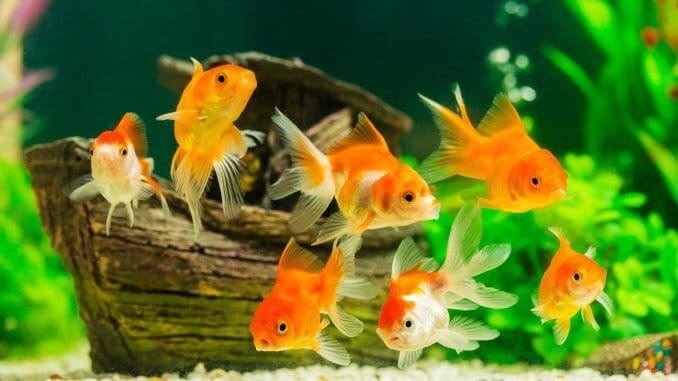
One of the most important things to consider when keeping a new goldfish is the diet you’ll provide. Not all fish can eat all foods. A nutritional, varied diet will keep your fish healthy.
While goldfish are a diverse group, each variety shares a similar diet because they all originate from carp in Asia.
Whether you’re keeping fancies, or the popular comet goldfish, their diet will look pretty similar. As omnivores, there is almost too much choice when deciding which foods to use. Once you’ve decided on the food, there are even more questions you have to answer, including when and how much to feed them.
This article will discuss what goldfish eat in the wild, how to replicate this in an aquarium, how much and how often to feed them, and much more…
TABLE OF CONTENTS
What Do Goldfish Eat (In The Wild)?
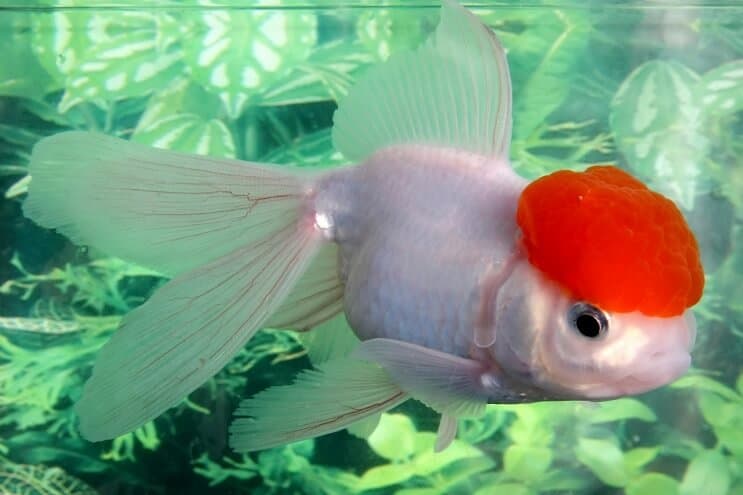
There are lots of different varieties of goldfish (Carassius auratus), which humans started to domesticate in 700AD. They all come from the Cyprinidae family, making them closely related to carp.
Their relation to carp means that goldfish prefer similar habitats. It’s important to understand their habitat, so you can start to get an understanding of the types of food they would naturally eat.
In the wild, carp live in slow-moving freshwater rivers and lakes throughout Asia.
Conditions can vary between these bodies of water, the temperature can range from 42 to 82°F. The water can be quite murky as dirt from the riverbed is carried downstream in the current.
Usually, there’s lots of plant life, some floating on the surface of the water and others rooted to the river bed. Algae grow on top of the substrate and on any rocks/logs sitting above. These plants act as the main food source unless the goldfish find something else.
As omnivores they don’t tend to struggle finding food since they can eat almost anything that passes by, both plant and animal matter. The search for food is made even easier because there’s so much plant life around.
This is a healthy choice because vegetation contains lots of fiber which is beneficial for digestion.
Other nutrients come from the rest of their diet, which is more inconsistent because they’ll eat whatever they find in the water.
This could be small insects, eggs, or juvenile animals. They’ll pretty much eat anything as long as it can fit into their mouth.
The best way to provide a healthy diet at home is to give them the same foods they’d come across in the wild.
What Do Adult Goldfish Eat?
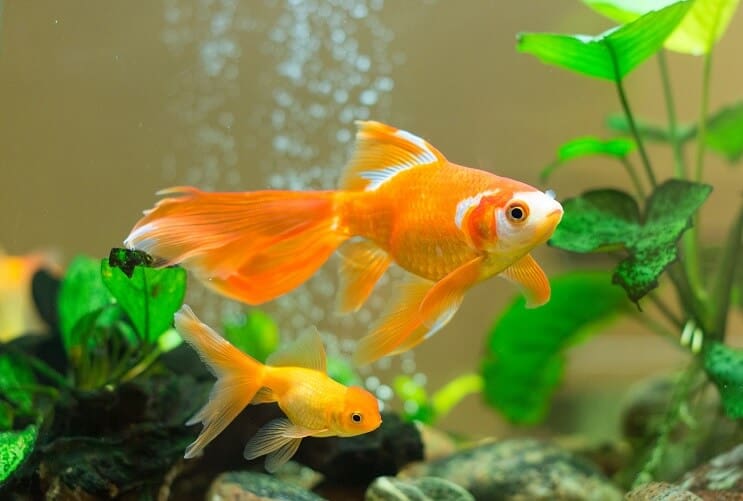
An adult goldfish isn’t as restricted with what they can eat, so you shouldn’t have a problem finding suitable foods for feeding time.
The most common examples are store-bought foods flake/pellet foods.
These will have been made to contain lots of different nutrients to give your fish everything they need. Pellets sink to the bottom quickly whereas flakes float on the surface for a while. This makes flakes much more accessible, though they will happily head to the bottom of the tank to fetch the pellet foods.
Live foods are an easy way to introduce some protein to their diet. They also encourage some different more natural behaviors since the food isn’t sat waiting for them. Some examples of live foods are ghost shrimp, brine shrimp, and daphnia.
Goldfish can even eat snails, so you might want to avoid keeping freshwater varieties such as mystery snails with them. Some people don’t like to keep live foods in which case frozen foods are another more convenient way to provide some protein.
If you’re still struggling with ideas, then there’s plenty of food you can use from around your home. Go around your kitchen and gather up some fruit or green vegetables. Adding small pieces to the tank makes a tasty snack.
As a side note, if your goldfish have stopped eating and you don’t know why, make sure the tank is clean and try switching up the foods you’re giving them.
Check the temperature of the tank too, making sure that it’s within the recommended range. If it’s too cold, it may cause digestive problems.
List of Things to Feed Your Goldfish
- Algae
- Algae Wafers
- Aquarium Plants
- Bloodworms
- Brine Shrimp
- Daphnia
- Fish Pellet Foods
- Flake Foods
- Frozen Foods
- Fruit
- Green Vegetables
- Homemade Fish Foods
- Insects
- Mosquito Larvae
- Shrimp Pellet Foods
- Small Live Foods
- Squid
- Worms
What Do Fry Goldfish Eat?
Feeding fry might be harder than you think, the diet you choose can affect how they grow. The biggest challenge they face is finding food that’s small enough to fit in their mouths.
Those that are newly hatched from eggs are a lot smaller than their parents. They’ll grow quite quickly, but in order to do so, they need to feed.
Juveniles like to stay in the safety of the plants for a while. Here they will take small bites from the plants or vacuum up any debris on the floor. Algae are an easy source of food for them too.
The foods you add need to be small. This can be done by breaking them down, just rub down flake foods into tiny parts. Alternatively, you can buy foods that are specifically designed for fry. These are usually high in protein and are sold as liquids, powders, or flakes.
Certain foods are hard to eat. Live foods are probably too big and could escape juvenile goldfish. Frozen foods will have to be chopped up finely before being added.
If you’re keeping the young in a breeding tank, then they can be moved back with the adults at around an inch long. At this point, they should be able to eat similar foods too.
How Often Should You Feed Goldfish
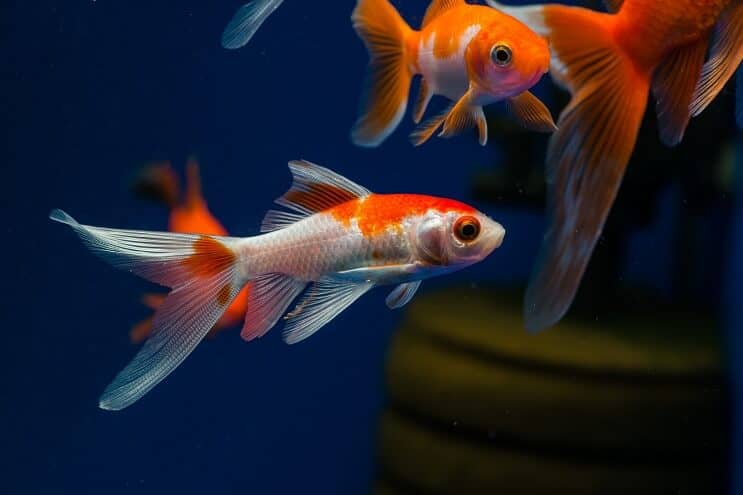
If you manage to stick to regular feeding times, your fish will learn the routines and come to expect foods at certain points of the day.
They’ll start to become more active and gather by the surface when they think they’re about to be fed. If they do this in between feeds, resist the urge to feed them and stick to your plan.
Aim to feed your goldfish 2-3 times a day. Their digestive systems aren’t good enough to handle a whole day’s worth of food at once. In the wild they would spread their eating over the entire day.
For each feeding session, give them an amount of food that they can easily finish in 2 minutes.
Even if they look like they could eat more, stop feeding them because they’re probably just being greedy. It’s safer to feed a little less if you’re unsure. Any more food will lead to overfeeding and bloating. Watch out for swelling around the stomach as this is the main indicator for bloating.
If there’s any excess food leftover after the 2 minutes of feeding, try to remove it. This reduces overfeeding and stops it from decaying in the tank.
Left-over food can break down and affect the quality of the water in the tank, which in turn can make the fish stressed and cause them to eat less.
The Importance of Correct Diet and Nutrition
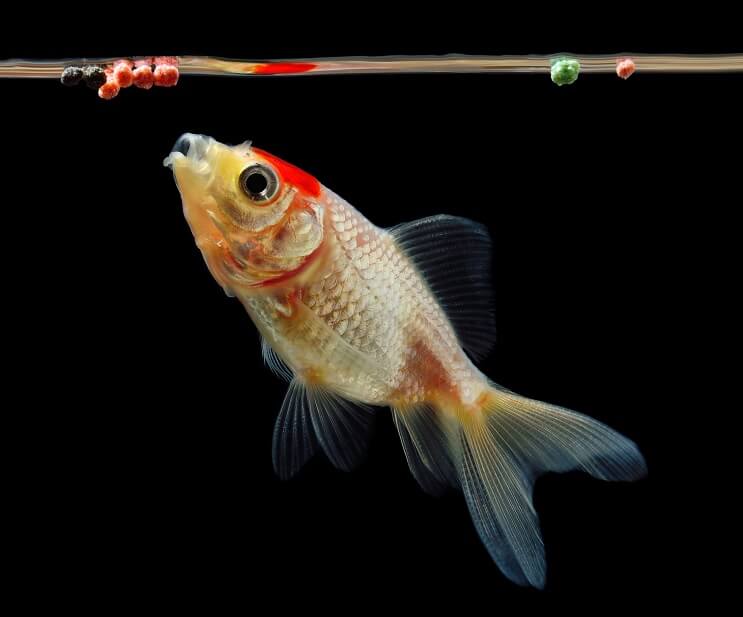
When a fish feels stressed in its tank, a common response is to stop eating. There are a few things you can do to stop this from happening.
If you want to keep your fish healthy and feeding happily then you need to match your aquarium as closely as you can to their natural habitat.
A fine gravel/sand works well for the base of the tank. Any uneaten food will sit on top waiting to be scavenged instead of falling between the grains.
Add plenty of plants in lots of different places around the tank. These will mainly be used for shelter; the food you add should stop your fish from nibbling on them.
The plants may get bitten now and then but not to a point where they’ll die off, especially if you’re using fast-growing species like hornwort.
Rocks and caves will be appreciated too. They can be used as little hideaways and small amounts of algae can grow on their surface. Algae are another food source for your goldfish or any other algae eaters you’re keeping with them.
A diet isn’t as simple as giving your fish some food and leaving them to it. You’re in charge of what they get to eat, so you need to make sure they’re getting all the nutrients that they need. A varied diet helps them to sport their bright colorations whereas poor nutrition may result in faded pale colors.
When thinking about nutrition, proteins and fats are two of the most important things to consider.
Proteins are needed for growth and development. This is vital for the fry, which grows rapidly until they mature. After this, the amount of protein in the diet can be lowered, but not removed altogether (from about 45% to 30%). The best sources of protein are meats such as worms and small insects.
Some of their energy will come from the fats which they eat; they should make up roughly 5-10 percent of the diet. Most store-bought fish foods contain fatty oils, but fats can be found in pretty much everything; plant matter is probably the least effective source though.
Any vitamins and minerals that your fish need will be taken from foods or the water. A varied diet will give them enough of everything without the need for supplements.
FAQs about Feeding Goldfish
How Long Can Goldfish Go Without Food?
It is thought that they can survive for between 8 days to two weeks without food. There is evidence of them surviving for over four months after they were cut off from human contact after an earthquake in New Zealand.
If you’re leaving your goldfish while you go on holiday, we recommend either having a friend or family member come over and feed them; or use an automatic fish feeder.
Do Goldfish Have Teeth?
Goldfish do have teeth, but they’re not where you’d expect them to be! They are called pharyngeal teeth and are near the back of their throats. They’re flat, like human molars, and the fish use them to crush and grind their food.
How Often Should I Feed My Goldfish?
Feed your goldfish two to three times per day. As they get familiar with this schedule, they will get used to having a routine and you’ll notice them waiting near the top when it’s getting close to feeding time.
Summary
Feeding your goldfish doesn’t have to be difficult, in most cases it’s pretty easy. They are one of the easiest fish to feed due to their omnivorous lifestyle, so it’s hard to go wrong.
You can vary their diet from plant matter to live insects without receiving any complaints from the fish. Varying it up is the key.
A varied diet ensures that they’re getting all of the nutrients they need, and it keeps feeding times interesting for them. You’d get bored of having the same meal three times a day, so why should you offer three of the same meals to your goldfish?
If you vary their diet, feed them 2-3 feeds a day and make sure you’re not overfeeding them, you’ll be rewarded with healthy and beautifully colored fish.
What do you feed your goldfish? Let us know in the comments below…

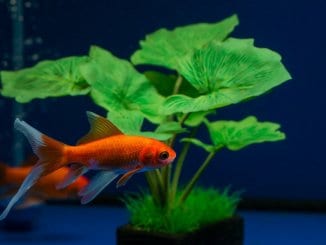
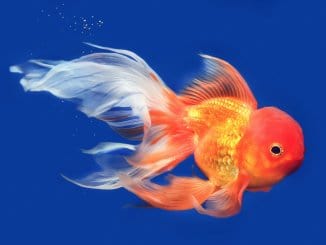
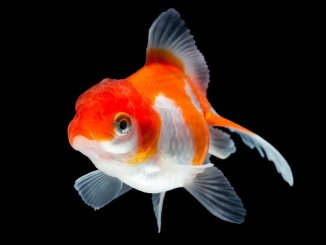
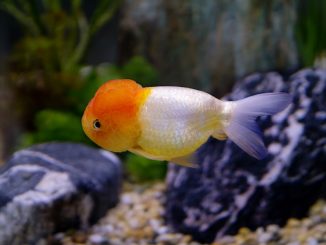
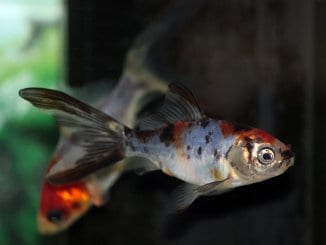
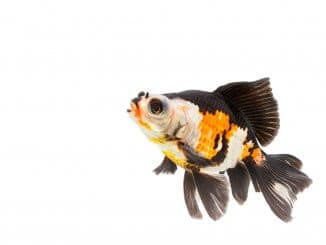
Be the first to comment